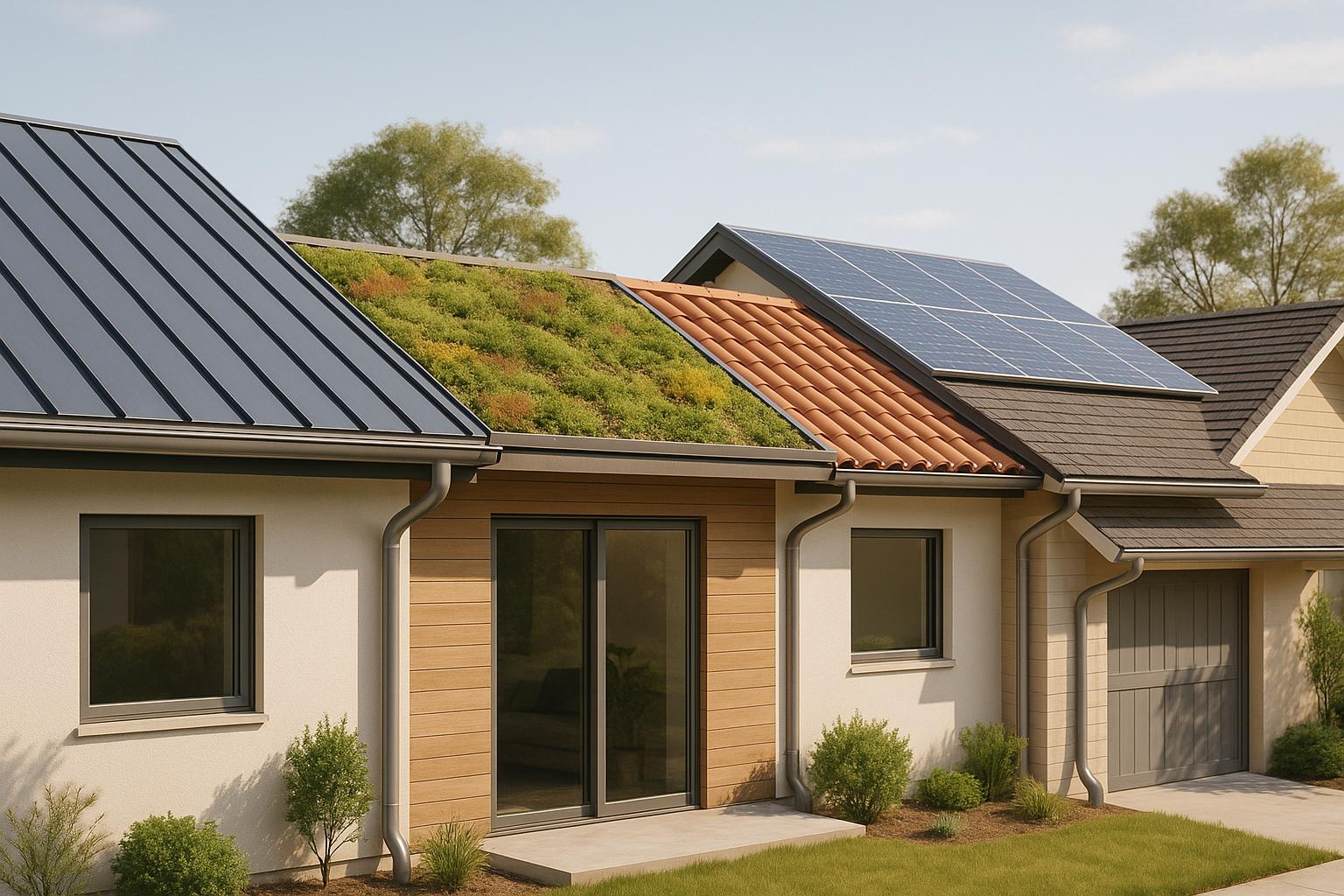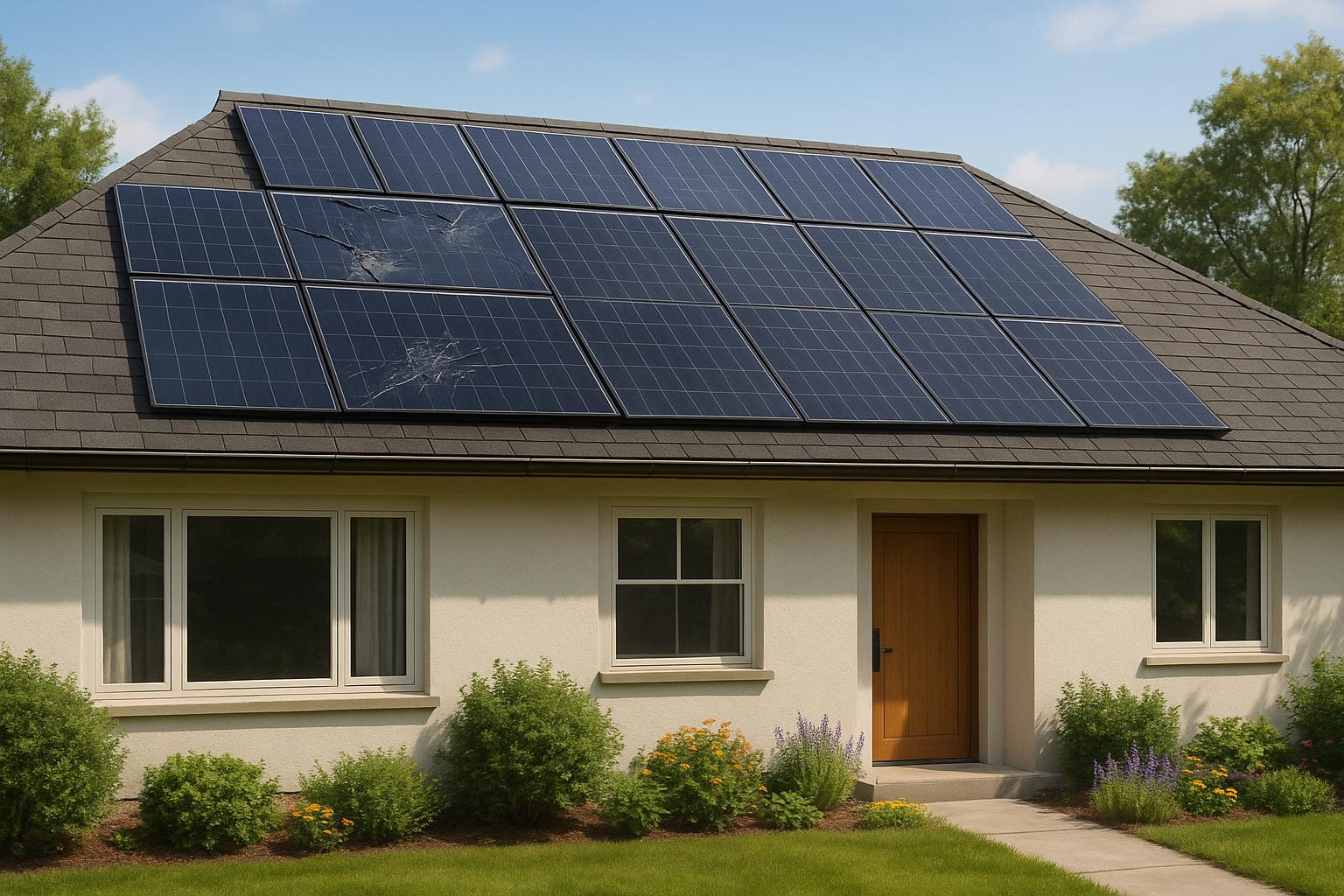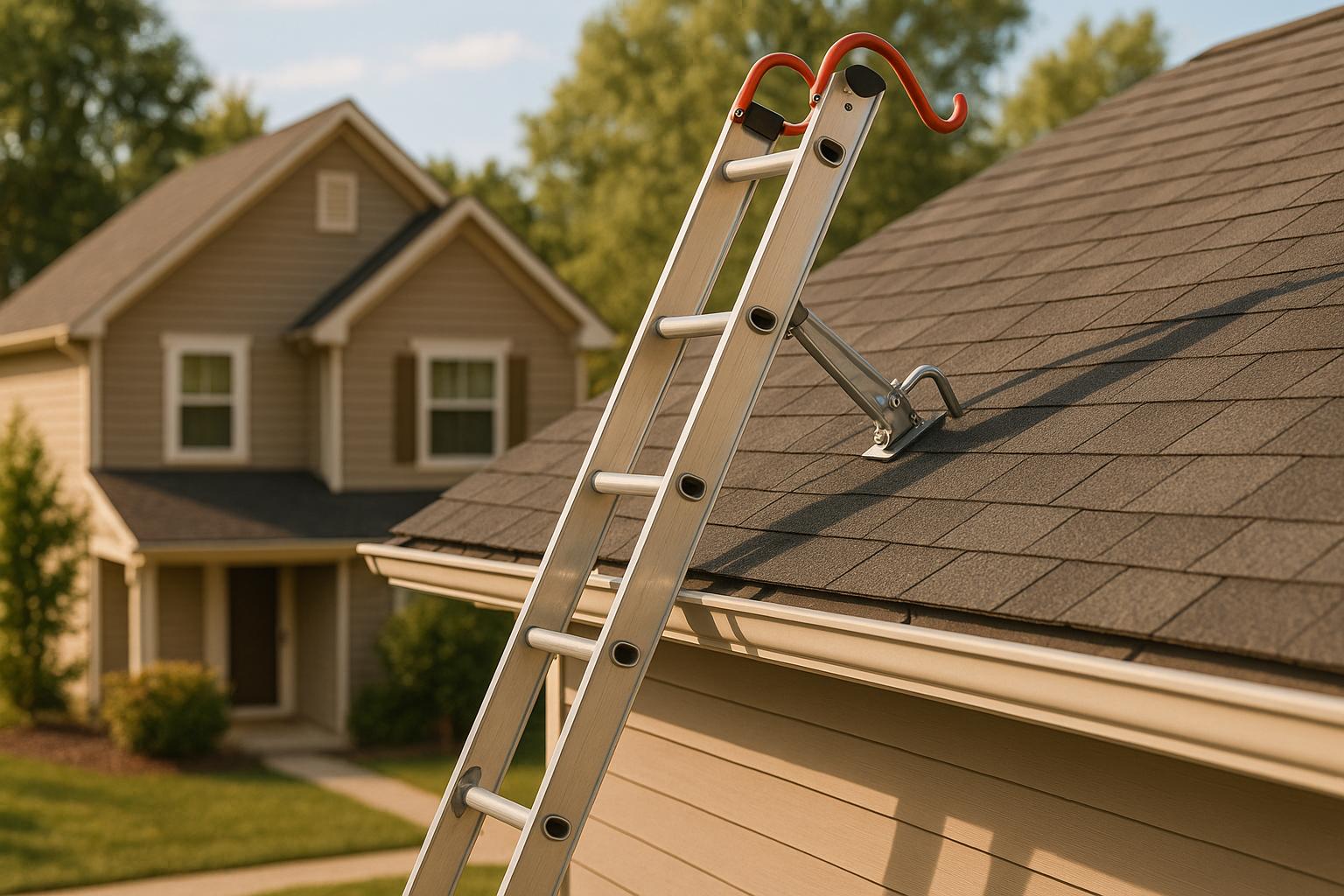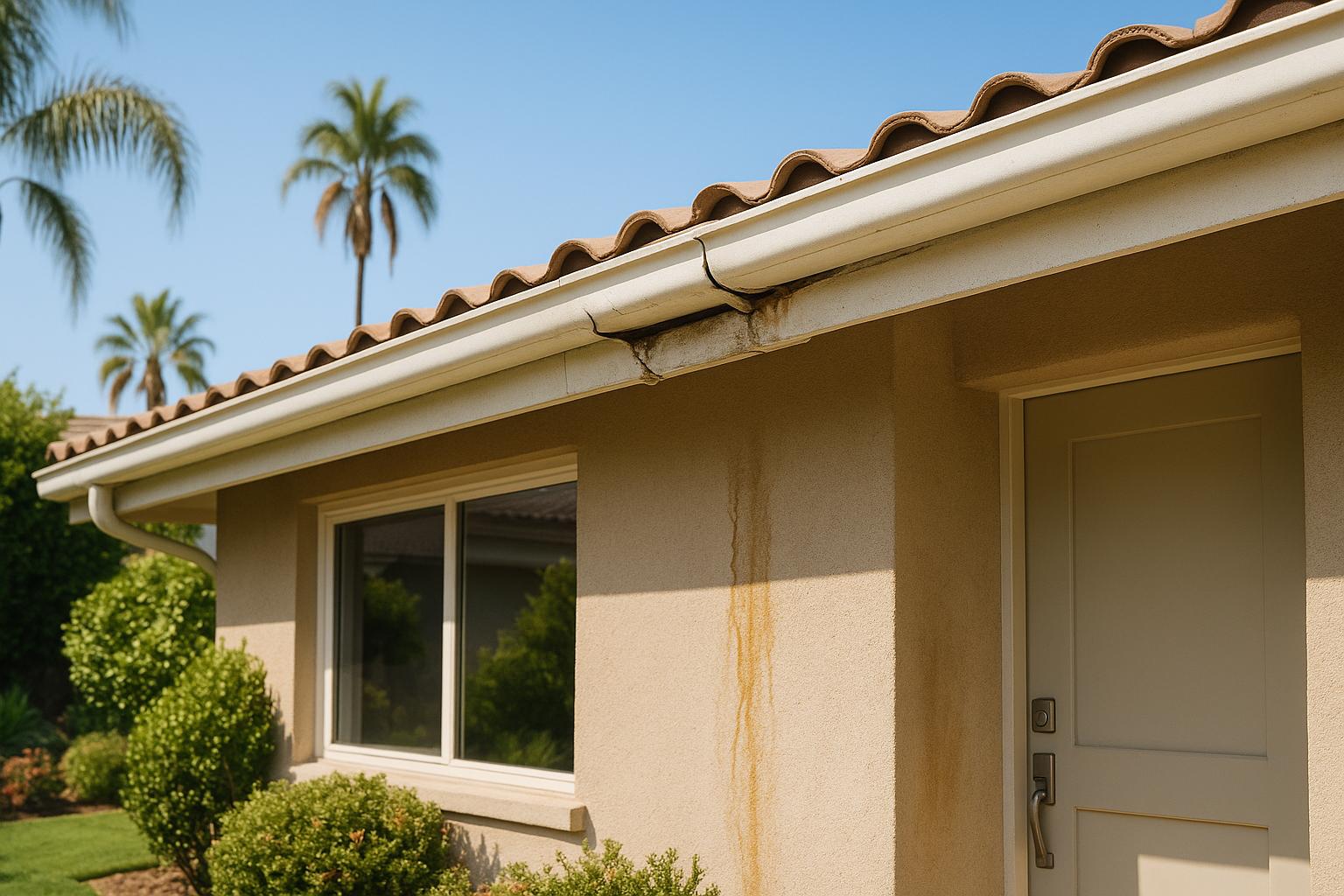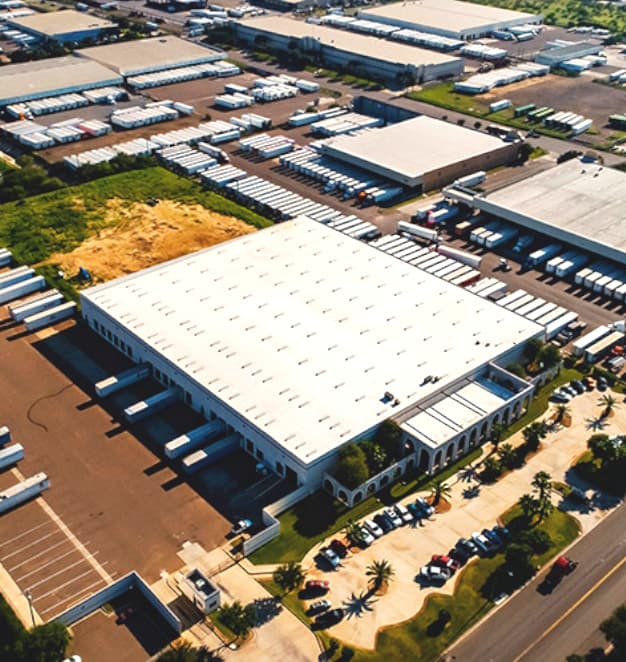Los Angeles faces water challenges, with over 85% of its supply imported. Choosing the right roof can help you collect rainwater efficiently and reduce reliance on external water sources. Here’s a breakdown of five roof types for water harvesting:
- Standing Seam Metal Roofs: Highly efficient (95%+ runoff), durable (40–70 years), and ideal for potable water collection. Costs $8–$15/sq. ft.
- Concrete/Clay Tiles: Moderate efficiency (85–90% runoff), long-lasting (50–100 years), and aesthetically pleasing. Costs $3–$8/sq. ft.
- Solar Panel Roofs: Dual-purpose for energy and water collection (90%+ efficiency), lasting 25–30 years. Costs $15–$25/sq. ft.
- Asphalt Shingles: Affordable but less durable (20–30 years) with 90% efficiency. Best for non-potable uses. Costs $2–$5/sq. ft.
- Green Roofs: Retains 40–80% rainfall, improves runoff quality, and lasts 40+ years. High upkeep and costs $15–$30/sq. ft.
Quick Comparison:
| Roof Type | Efficiency | Lifespan | Cost ($/sq. ft.) | Best Use |
|---|---|---|---|---|
| Standing Seam Metal | 95%+ | 40–70 years | 8–15 | Potable & non-potable |
| Concrete/Clay Tiles | 85–90% | 50–100 years | 3–8 | Potable & non-potable |
| Solar Panel | 90%+ | 25–30 years | 15–25 | Non-potable |
| Asphalt Shingles | 90% | 20–30 years | 2–5 | Non-potable |
| Green Roofs | Retention | 40+ years | 15–30 | Non-potable |
Key Takeaway: For maximum efficiency, durability, and water quality, standing seam metal roofs are the top choice. However, other options like clay tiles or solar panels can align with specific goals and budgets. Proper installation and maintenance are crucial for optimal water harvesting in LA’s semi-arid climate.
Rainwater Harvesting – Collection Surfaces
1. Standing Seam Metal Roofs
Standing seam metal roofs are a smart option for water harvesting in Los Angeles. Their smooth, non-porous surface makes them highly efficient at directing rainfall into collection systems, even during the city’s limited rainy periods.
Water Collection Efficiency
These roofs excel in water collection, offering the highest efficiency among roofing materials. Unlike porous materials like clay or concrete tiles, which tend to absorb water, the seamless surface of metal roofs ensures maximum runoff. This means you can collect more water from each rainfall, which is particularly valuable in a region where water is scarce. Additionally, this efficiency helps maintain high water quality, a key factor for potable uses.
Water Quality
For those considering potable water collection, standing seam metal roofs are an excellent choice. According to the American Rainwater Catchment Systems Association (ARCSA):
"standing seam roofs, powder coated or enameled, Galvalume (zinc + aluminum alloy) with non-toxic baked or enamel finish are appropriate for potable use with non-toxic finishes and appropriate components, tanks, and post-tank treatment."
These roofs are designed to avoid issues like harmful leaching, which can occur with some galvanized metal roofs, or chemical off-gassing, often associated with asphalt shingles. Properly finished metal roofs ensure safer, cleaner water for drinking and other uses.
Durability and Maintenance in LA’s Climate
Los Angeles’ intense summer heat and occasional heavy rains demand a durable roofing solution, and standing seam metal roofs fit the bill. With a lifespan of 40 to 70 years, they are built to last. Their interlocking design reduces the risk of water intrusion during winter storms, making them a reliable choice for homeowners. As an expert from Michaels Sheet Metal explains:
"The durability of metal roofing translates into long-term cost savings for property owners, who will only need to replace or repair their roofs less frequently. Additionally, standing seam metal roofs require very little maintenance. The interlocking design prevents water intrusion, and the metal panels resist cracking, warping, and fading. This means less money on repairs and maintenance over the roof’s lifespan."
Another benefit? Their fire-resistant properties provide added safety in wildfire-prone areas, a major concern for many Los Angeles County residents.
Cost and Sustainability
While the upfront cost of standing seam metal roofs is higher, their long-term benefits make them a worthwhile investment. Thanks to their durability and low maintenance needs, they save money over time. Many of these roofs also incorporate recycled materials and are fully recyclable at the end of their life cycle. This makes them a great fit for environmentally conscious homeowners who prioritize water conservation and sustainability.
For Los Angeles property owners focused on efficient water harvesting, standing seam metal roofs offer exceptional water collection, clean water quality, and long-lasting performance. Their ability to thrive in LA’s challenging climate makes them an ideal choice for maximizing water harvesting efforts.
2. Concrete and Clay Tile Roofs
Concrete and clay tile roofs are a popular choice for many Los Angeles homes, offering a Mediterranean-style aesthetic along with decent performance for rainwater harvesting. While they don’t match the efficiency of metal roofs, they still provide reliable results when integrated into rainwater collection systems.
Water Collection Efficiency
When it comes to collecting rainwater, concrete and clay tiles perform moderately well. Clay tiles absorb about 6% of water, while concrete tiles absorb roughly 13%. This absorption is due to the porous nature of these materials, which slightly reduces their overall collection efficiency compared to non-porous surfaces like metal. Clay tiles, however, maintain a runoff coefficient of 85% to 90%, which reflects their ability to channel rainwater effectively. This efficiency also plays a role in determining the quality of the water collected.
Water Quality
The water quality collected from these roofs can vary. Clay tile roofs are often preferred for rainwater harvesting because they leach fewer pollutants into the water. This can result in cleaner, higher-quality rainwater. On the other hand, concrete tile roofs may raise the pH of the harvested water. For example, one study recorded an average pH of 7.2 for rainwater collected from concrete tiles. While this pH level generally meets drinking water standards, it’s a factor to consider during system planning. Additionally, both types of tile roofs may develop biological growth, such as moss or lichens, over time, which can further impact water quality.
Durability and Maintenance in LA’s Climate
Tile roofs are well-suited for Los Angeles’ climate. Both clay and concrete tiles handle the region’s salt air, humidity, and intense sunlight without issue. They also excel in fire resistance, which is critical in wildfire-prone areas. In fact, tile roofs achieve the highest fire rating available for both the material and the installed system.
In terms of longevity, clay tiles can last more than 100 years with proper care, while concrete tiles typically last around 50 years. This far outpaces the lifespan of asphalt shingles, which usually need replacement after 20 to 30 years. Regular maintenance is key to maximizing this durability. Broken tiles should be replaced quickly to protect the underlayment, which itself lasts about 30 years if high-quality materials are used. Routine tasks like clearing debris and annual inspections are generally sufficient to keep these roofs in excellent condition, and some experts even suggest that they require minimal upkeep once installed.
Cost and Sustainability
The cost of tile roofs depends on the material. Clay tiles typically range from $700 to $1,000 per 100 square feet, with premium options exceeding $3,000. Concrete tiles are more affordable, averaging $400 to $900 per 100 square feet, with high-end products around $1,000. While concrete tiles are easier on the budget, clay tiles often justify their higher cost with greater longevity and performance. Installation costs can also vary since clay tiles are more fragile and require extra care during handling and installation.
From a sustainability perspective, these roofs are a long-term investment. With lifespans of 50 to 100 years, they reduce the need for frequent replacements, cutting down on waste. Their thermal properties also help with energy efficiency. For instance, concrete tiles can reflect up to 77% of sunlight, while the curved design of terra cotta tiles promotes airflow, reducing heat buildup.
For Los Angeles homeowners, concrete and clay tile roofs offer a practical mix of durability, visual appeal, and moderate water collection capabilities, making them a solid choice for long-term rainwater harvesting systems.
3. Solar Panel Roofs
Solar panel roofs bring together renewable energy generation and rainwater collection, offering an eco-friendly solution for Los Angeles homeowners. While they might not be the first option that comes to mind, these systems provide a unique blend of benefits for those aiming to reduce their environmental impact.
Water Collection Efficiency
Solar panels are built with smooth, non-porous surfaces that make them excellent for directing rainwater into collection systems. Their sealed glass and aluminum design ensures rain flows efficiently toward gutters and downspouts, while their flat or slightly angled structure helps prevent water from pooling. This efficiency is especially useful during Los Angeles’ brief but heavy winter rains, allowing for maximum water capture.
Water Quality
One standout advantage of solar panel roofs is the cleaner runoff they produce compared to traditional asphalt shingles. Their sealed surfaces reduce the risk of contaminants, unlike porous materials such as clay or concrete tiles. However, water quality can still be affected by factors like dust, bird droppings, or residue from mounting systems. Solar panels with plastic covers may also pose a risk of chemical leaching. To ensure safe, potable water, experts recommend using a multi-stage filtration system with sequential filters, a carbon block, and UV sterilization. Including a roof washer to discard the initial runoff can further improve water quality by removing debris [29, 30]. This combination of efficiency and cleaner runoff makes solar panel roofs an appealing option for Los Angeles residents looking to combine renewable energy with water harvesting.
Durability and Maintenance in LA’s Climate
Solar panels are built to endure tough conditions, such as hail, strong winds, and intense sunlight, making them well-suited for Los Angeles. Most systems last 25–30 years (and up to 40 under ideal conditions), maintaining 80–90% of their capacity after 25 years with minimal annual degradation (0.5–1%). While LA’s climate – marked by extreme heat, dust, and air pollution – can impact performance over time, regular cleaning and professional inspections can help keep the system running efficiently.
Prime American Roofing offers professional solar panel installation services, ensuring proper integration with water collection systems while maintaining the structural strength needed for LA’s unique climate.
Cost and Sustainability
Though solar panel roofs come with higher upfront costs, they pay off in the long run. Homeowners benefit from lower electricity bills, tax incentives, and efficient water collection. On a larger scale, the potential for distributed solar energy is enormous. For example, U.S. rooftops alone could generate an estimated 1,432 terawatt-hours of power annually.
"The only way is through a combination of distributed and utility-scale solar", – Robert Margolis, Researcher, National Renewable Energy Laboratory
With their long lifespan and dual-purpose functionality, solar panel roofs reduce the need for frequent replacements while supporting energy independence and water conservation. For Los Angeles homeowners, this makes them a practical and eco-conscious choice for water harvesting and renewable energy generation.
sbb-itb-d1d6490
4. Asphalt Shingle Roofs
In Los Angeles, where water conservation is critical, even common roofing systems like asphalt shingles can play a role in rainwater harvesting. Asphalt shingles are the most popular roofing material in the U.S., covering over 80% of homes. While they may not be the most efficient option, they allow LA homeowners to collect rainwater without needing to replace their roofs.
Water Collection Efficiency
Asphalt shingle roofs perform reasonably well in collecting rainwater, with an efficiency factor of 0.9. This means they can capture about 90% of the rain that falls on them. Their textured surface slightly reduces efficiency compared to smoother materials, but they still deliver solid results. For example, a 1,200-square-foot roof can collect approximately 748 gallons per inch of rain, while a larger 2,000-square-foot roof might yield around 1,246 gallons. In a typical 1.5-inch storm, the larger roof could generate nearly 1,870 gallons of water. With Santa Clarita receiving about 15 inches of rain annually, even asphalt shingle roofs can provide significant water collection opportunities.
To optimize rainwater collection, it’s important to install inlet screens to keep debris out of the system. Next, let’s look at water quality considerations for these roofs.
Water Quality
While asphalt shingles are durable enough to handle LA’s intense climate, runoff from these roofs may carry chemical residues. This makes filtration and first-flush diverters critical, especially if the water is intended for irrigation. The distinction between using rainwater for drinking versus irrigation is key. As Laura from Greywater Action explains:
"Generally speaking, asphalt shingles roofs are considered safe for irrigation of any plants. Of course you can’t know the actual water quality off your own roof water unless you were to test it, so each person has to make the decision for themselves about what feels safe. Also, there is a big difference in risk from drinking rainwater to irrigating with it."
For added safety, filtration systems and first-flush diverters are essential to remove contaminants, especially from the initial runoff. Recent studies have also highlighted concerns about PFAS in rainwater collected from all types of roofs, including asphalt shingles.
Durability and Maintenance in LA’s Climate
Los Angeles’ hot and dry climate poses unique challenges for asphalt shingles. While they are affordable and visually appealing, extreme heat can cause the roof surface to reach temperatures of 150°F or higher on hot summer days. This intense exposure can lead to brittleness, cracking, pigment loss, curling, or granule shedding, all of which shorten the roof’s lifespan. In LA, asphalt shingles typically last between 15 and 25 years, though some premium options can last up to 30 years with proper care.
| Shingle Type | Lifespan |
|---|---|
| Premium asphalt shingles | 20 to 30 years |
| Architectural/dimensional asphalt shingles | 15 to 25 years |
| 3-tab shingles (properly maintained) | 10 to 20 years |
Regular inspections and timely repairs are essential to prolong the life of asphalt shingle roofs and prevent damage caused by debris. As Roof Repairs CA advises:
"Routine maintenance is one of the best ways to preserve your shingles. Regular inspections can catch small issues – like lifting edges, granule loss, or flashing gaps – before they become major problems."
For homes in areas with extreme heat, cool roof shingles or reflective coatings can help minimize heat damage.
Cost and Sustainability
Asphalt shingles are one of the most affordable options for homeowners looking to integrate rainwater harvesting into their existing roofs. Since most homes in LA already have asphalt shingle roofs, water collection can be achieved without the expense of a roof replacement. However, the environmental impact of asphalt shingles is a concern. The U.S. generates about 123 million tons of asphalt shingle waste annually, and only around 10% of it is recycled.
Companies like Prime American Roofing specialize in installing and maintaining asphalt shingle roofs, ensuring they work efficiently with water collection systems. For homeowners who already have asphalt shingle roofs, the focus should be on proper system design and regular upkeep. With the right filtration, first-flush diverters, and consistent maintenance, asphalt shingle roofs can effectively support water conservation efforts while providing reliable performance for years to come.
5. Green Roofs
Green roofs combine layers of vegetation and engineered soil to naturally manage stormwater. While they don’t channel water into tanks like traditional systems, they retain a significant amount of rainwater and offer numerous environmental perks for properties in Los Angeles. This method blends the practicality of water management with the beauty of nature.
Water Collection Efficiency
Green roofs act like natural sponges, soaking up and slowly releasing rainwater. They can retain between 40% and 80% of rainfall. The vegetation and soil layers absorb the water, which is then gradually released through evapotranspiration. This process not only reduces runoff but also mimics the water cycle found in natural ecosystems.
Water Quality
Beyond water retention, green roofs improve the quality of runoff. Acting as natural filters, they capture pollutants and airborne particles. As rainwater passes through the soil and vegetation, many contaminants are removed. This cleaner runoff can be repurposed for non-drinking uses, such as watering plants or landscaping.
Durability and Maintenance in LA’s Climate
The Mediterranean climate of Los Angeles presents unique challenges for green roofs. Summers bring intense heat, which can strain plants and require careful irrigation. However, green roofs help mitigate heat by reducing surface temperatures by as much as 50°F (10°C) compared to conventional roofs.
Given the region’s limited rainfall, drought-tolerant plants are essential for green roofs. Additionally, strong winds in the area mean that vegetation and soil need to be securely anchored to prevent erosion. While green roofs demand more upkeep – like pruning, weeding, and fertilizing – than traditional roofs, they offer significant energy savings, cutting cooling energy use by up to 75%.
Cost and Sustainability
Though green roofs come with a higher upfront cost compared to standard roofing, they deliver long-term benefits. For instance, their lifespan is about twice that of traditional roofs. Installation involves structural reinforcements, waterproofing, and selecting plants suited to LA’s dry conditions.
Green roofs reduce energy consumption by up to 30%, combat the urban heat island effect, support biodiversity, improve stormwater management, and lower greenhouse gas emissions. In Los Angeles, they can help reduce local temperatures by as much as 3°C.
"Green roofs are not designed and implemented as conventional roof gardens, but rather as engineering structures."
One noteworthy example is LA’s green streets project, launched in 2016, which has helped divert nearly 30 million gallons of stormwater runoff.
Urban ecologist Eric Sanderson highlights the broader impact of such initiatives:
"Rewilding a city can introduce resiliency from storms and droughts, but also provides a deeper human benefit. Just like replacing concrete with mass timber, astroturf with grass, and underground culverts with daylighted streams, more nature, along with more nurturing architecture, are how cities become welcoming habitats instead of human warehouses."
For homeowners in LA thinking about green roofs, partnering with experienced professionals like Prime American Roofing ensures proper structural evaluation and installation. Choosing green roof technology not only supports water conservation but also promotes a more sustainable and livable urban environment.
Roof Type Comparison Chart
When deciding on the best roof type for water harvesting in Los Angeles, it’s important to weigh several factors. The table below provides a side-by-side comparison of key considerations for each roof type.
| Roof Type | Water Collection Efficiency | Water Quality | Durability | Maintenance | Cost | Best Use |
|---|---|---|---|---|---|---|
| Standing Seam Metal | 95%+ runoff coefficient | Excellent – lowest bacteria levels | 40–70 years | Low – occasional cleaning | High upfront ($8–$15 per square foot) | Potable & non-potable |
| Concrete/Clay Tile | 85–90% runoff coefficient | Good – comparable to metal | 50–100 years | Moderate – annual cleaning | Moderate ($3–$8 per square foot) | Potable & non-potable |
| Solar Panel | 90%+ (smooth surface) | Good – minimal contamination | 25–30 years | Low – standard cleaning | High upfront ($15–$25 per square foot) | Non-potable water applications |
| Asphalt Shingle | 90% runoff coefficient | Fair – potential grit contamination | 20–30 years | Moderate – inlet screens needed | Low ($2–$5 per square foot) | Non-potable water applications |
| Green Roof | Limited runoff – designed for retention | Fair – higher organic content possible | 40+ years | High – regular plant care | Very high ($15–$30 per square foot) | Non-potable water applications |
Collection Efficiency Breakdown
Looking closer at collection efficiency, standing seam metal roofs take the lead with a runoff efficiency of over 95%, capturing nearly all available rainwater. Concrete and clay tiles follow closely with efficiencies between 85–90%. Interestingly, research conducted in Spain highlights that sloping, smooth roofs can collect up to 50% more rainwater than flat, rough surfaces. This is particularly relevant for Los Angeles, where sloped roofs are common and can significantly boost water harvesting potential.
Water Quality Considerations
Water quality is another critical factor. Metal roofs consistently produce the cleanest water, while concrete and clay tiles perform similarly when properly maintained. As noted by Vele Livhuwani et al.:
"Different roofing materials did not significantly affect the quality of the harvested rainwater".
Ultimately, the quality of harvested water depends on both the material used and the frequency of maintenance.
Long-term Value Analysis
When it comes to long-term value, standing seam metal roofs stand out despite their higher upfront cost. Their unmatched collection efficiency, minimal maintenance requirements, and long lifespan (40–70 years) make them an excellent investment. Concrete and clay tiles offer similar durability at a more moderate price, making them a great choice for those balancing performance and budget. On the other hand, asphalt shingles, while inexpensive initially, often require additional measures like inlet screens to address grit contamination, making them better suited for non-potable uses. Green roofs, primarily designed for water retention rather than runoff collection, demand higher maintenance and are also best for non-potable applications.
For Los Angeles homeowners focused on water harvesting, Prime American Roofing advises carefully weighing these factors against your specific needs. Whether you prioritize maximum efficiency or aim to stay within a budget, understanding these metrics will help you choose the best roofing solution for your property.
Conclusion
Selecting the right roof for water harvesting in Los Angeles can significantly impact both the quantity and quality of rainwater collected. Considering that outdoor water use accounts for roughly 50% of a household’s total water consumption in LA, making the most of rainwater collection is a smart move for both conserving resources and cutting costs.
Different roof materials offer varying levels of efficiency and water quality. For example, sloping, smooth roofs can collect up to 50% more rainwater than flat, rough surfaces. Among the options, standing seam metal roofs stand out with over 95% collection efficiency, making them a top choice for both drinking and non-drinking purposes. Concrete and clay tiles are durable and deliver good water quality, while asphalt shingles provide a budget-friendly option, though they are better suited for non-potable uses.
Choosing the right materials also helps prevent contamination, ensuring the water collected is safe for its intended use.
Given LA’s Mediterranean climate, with an average annual rainfall of about 14 inches, professional installation and maintenance become essential to maximize your system’s effectiveness. Proper design – such as ensuring the correct slope, installing efficient gutters, and adding debris screens – plays a key role in optimizing performance. This level of precision highlights why professional expertise is so valuable.
Prime American Roofing specializes in water harvesting roof installations tailored to Southern California’s unique environment. Their services cover everything from roof and gutter installations to ongoing maintenance, ensuring your rainwater collection system performs at its best. They also offer free inspections and custom solutions designed to meet LA’s specific climate and water conservation needs.
For long-term success and compliance with local regulations, consulting roofing professionals is the best way to achieve reliable and efficient rainwater collection.
FAQs
What type of roof is best for water harvesting in Los Angeles?
The ideal roof for water harvesting in Los Angeles is one that balances durability, efficiency, and compatibility with the area’s climate. Metal roofs, especially standing seam designs, are often a top choice. Their smooth surface ensures water flows easily into collection systems, and they’re built to withstand weather challenges while requiring minimal upkeep – making them a solid long-term option.
When selecting a roof, prioritize designs with a slight slope. This feature enhances water runoff, improving collection efficiency – an important factor in a city like Los Angeles, where water conservation is a key concern. To ensure the best results, consult local professionals who specialize in sustainable roofing systems and understand the unique needs of the region.
How do I maintain my roof to maximize water harvesting efficiency?
To keep your roof ready for water harvesting, regular upkeep is essential. Begin by cleaning out gutters and filters every 2–4 months to avoid blockages and contamination. Check the roof surface often and clear away debris like leaves or dirt, as these can lower water quality. If you have a metal roof, give it a periodic wash to remove dirt and algae buildup. Steer clear of asphalt shingles – they can leach harmful substances into the water.
Don’t forget to inspect the entire system regularly. This includes gutters, downspouts, and storage tanks, ensuring everything works as it should. Replace or clean filters when needed to maintain water quality and harvesting efficiency. Staying on top of these straightforward tasks can help your system last longer and provide clean water collection throughout the year.
What are the environmental benefits of using specific roof types for rainwater harvesting in Los Angeles?
Using the right roof type for rainwater harvesting in Los Angeles offers multiple benefits for the environment. It helps cut down stormwater runoff, which reduces soil erosion, limits pollution, and lessens the burden on local sewage systems. This also keeps nearby waterways cleaner by preventing contamination.
On top of that, collecting rainwater decreases the need for treated municipal water, saving both energy and resources involved in water treatment and distribution. By selecting roofing materials and designs tailored for rainwater collection, you’re playing a part in creating a more efficient and environmentally friendly water management system for your community.

